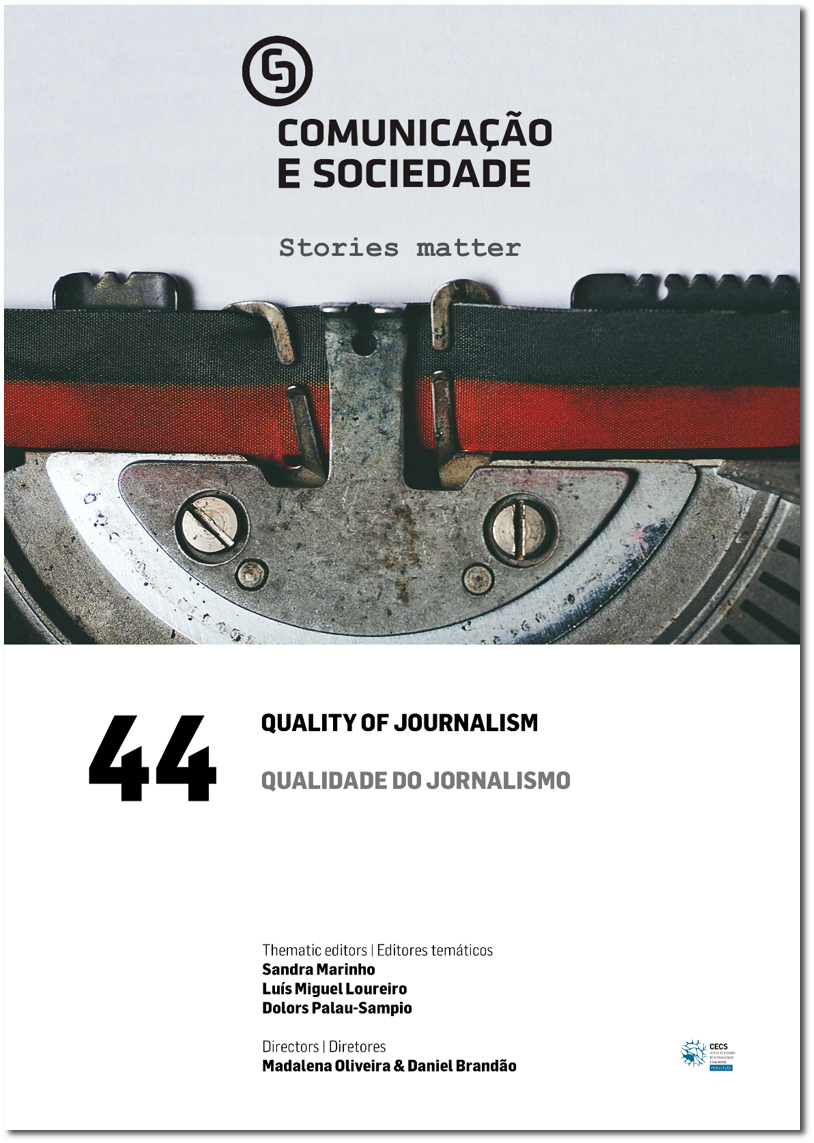Introductory Note: Quality of Journalism
DOI:
https://doi.org/10.17231/comsoc.44(2023).5491Downloads
References
Adam, G. S., & Clark, R. P. (2006). Journalism: The democratic craft. Oxford University Press.
Allern, S. (2002). Journalistic and commercial news values. News organizations as patrons of an institution and market actors. Nordicom Review, 23(1/2), 137–152. https://doi.org/10.1515/nor-2017-0327 DOI: https://doi.org/10.1515/nor-2017-0327
Bogart, L. (2004). Reflections on content quality in newspapers. Newspaper Research Journal, 25(1), 40–53. https://doi.org/10.1177/073953290402500104 DOI: https://doi.org/10.1177/073953290402500104
Carey, J. (1999). Lawyers, voyeurs, and vigilantes. Media Studies Journal, 13(2), 16–17.
Curran, J. (2005). Mediations of democracy. In J. Curran & M. Gurevitch (Ed.), Mass media and society (pp. 122–145). Hodder Arnold.
Curran, J., Iyengar, Sh., Lund, A. B., & Salovaara-Moring, I. (2009). Media system, public knowledge and democracy: A comparative study. European Journal of Communication, 24(5), 5–26. https://doi.org/10.1177/0267323108098943 DOI: https://doi.org/10.1177/0267323108098943
Edmonds, R. (2004). News staffing, news budgets and news capacity. Newspaper Research Journal, 25(1), 98–109. https://doi.org/10.1177/073953290402500108 DOI: https://doi.org/10.1177/073953290402500108
Franklin, B. (1997). Newszak and news media. Arnold.
Gómez-Mompart, J. L., Gutiérrez-Lozano, J. F., & Palau-Sampio, D. (2015). Los periodistas españoles y la pérdida de la calidad de la información: El juicio profesional. Comunicar: Revista Científica de Comunicación y Educación, 22(45), 143–150. https://doi.org/10.3916/C45-2015-15 DOI: https://doi.org/10.3916/C45-2015-15
Gómez-Mompart, J. L., & Palau-Sampio, D. (2013). El reto dela excelência: Indicadores para medir la calidad periodistica. In J. L. Gómez-Mompart, J. F. Gutiérrez-Lozano, & D. Palau-Sampio (Eds.), La calidad periodística: Teorias, investigaciones y sugerencias profesionales (pp. 121–137). Universitat Autònoma de Barcelona/Universitat Pompeu Fabra. DOI: https://doi.org/10.7203/PUV-ALG26-9164-8
Hackett, R. A., & Uzelman, S. (2003). Tracing corporate influences on press content: A summary of recent NewsWatch Canada research. Journalism Studies, 4(3), 331–346. https://doi.org/10.1080/14616700306486 DOI: https://doi.org/10.1080/14616700306486
Harris, J. (2001). The bottom line: Profits and journalism in newspapering. The HarvardInternational Journal of Press/Politics, 6(4), 106–112. https://doi.org/10.1177/108118001129172369 DOI: https://doi.org/10.1177/108118001129172369
Hermans, L., & Drok, N. (2018). Placing constructive journalism in context. Journalism Practice, 12(6), 679–694. https://doi.org/10.1080/17512786.2018.1470900 DOI: https://doi.org/10.1080/17512786.2018.1470900
Kovach, B., & Rosenstiel, T. (2003). The elements of journalism. Atlantic Books.
Lacy, S., & Martin, H. J. (2004). Competition, circulation and advertising. Newspaper Research Journal, 25(1), 18–39. https://doi.org/10.1177/073953290402500103 DOI: https://doi.org/10.1177/073953290402500103
Lacy, S., & Rosenstiel, T. (2015). Defining and measuring quality journalism. Rutgers School of Communication and Information.
Loureiro, L. M. (2023). Jornalismo e ativismo: Um repórter português do lado russo da guerra na Ucrânia. Communication, Technologies et Développement, (13), 1–23. https://doi.org/10.4000/ctd.8598 DOI: https://doi.org/10.4000/ctd.8598
Maguire, M. (2005). Changes in ownership affect quality of Oshkosh paper. Newspaper Research Journal, 26(4), 74–86. https://doi.org/10.1177/073953290502600407 DOI: https://doi.org/10.1177/073953290502600407
Marinho, S. (2015). Jornalismo e formação em mudança: Modelos e construções na análise do caso português. CECS.
Meijer, I. C. (2013). Valuable journalism: A search for quality from the vantage point of the user. Journalism, 14(6), 754–770. https://doi.org/10.1177/1464884912455899 DOI: https://doi.org/10.1177/1464884912455899
McNair, B. (2000). Journalism and democracy: An evaluation of the political public sphere. Routledge.
Meier, K. (2019). Quality in journalism. In T. P. Vos, F. Hanusch, D. Dimitrakopoulou, M. Geertsema-Sligh, & A. Sehl (Eds.), The international encyclopedia of journalism studies (pp. 1–8). Wiley. https://doi.org/10.1002/9781118841570.iejs0041 DOI: https://doi.org/10.1002/9781118841570.iejs0041
Meyer, P. (2004). The influence model and newspaper business. Newspaper Research Journal, 25(1), 66–83. https://doi.org/10.1177/073953290402500106 DOI: https://doi.org/10.1177/073953290402500106
Meyer, P., & Kim, K.-H. (2003). Quantifying newspaper quality: "I Know It When I See It". In Proceedings from the Association for Education in Journalism and Mass Communication (pp. 1–10). ERIC.
Molyneux, L., & Coddington, M. (2020). Aggregation, clickbait and their effect on perceptions of journalistic credibility and quality. Journalism Practice, 14(4), 429–446. https://doi.org/10.1080/17512786.2019.1628658 DOI: https://doi.org/10.1080/17512786.2019.1628658
Patterson, T. (2000). Doing well and doing good: How soft news and critical journalism are shrinking the news audience and weakening democracy — And what news outlets can do about that. Joan Shorenstein Centre on the Press, Politics and Public Policy.
Picard, R. (2000). Measuring quality by journalistic activity. In R. Picard (Ed.), Measuring media content, quality, and diversity: Approaches and issues in content research (pp. 97–103).
Media Economics, Content and Diversity Project; Media Group, Business Research and Development Centre.
Picard (2004). Commercialism and newspaper quality. Newspaper Research Journal, 25(1), 54–65. https://doi.org/10.1177/073953290402500105 DOI: https://doi.org/10.1177/073953290402500105
Pinto, M., & Marinho, S. (2004). A qualidade em jornalismo: Problematização e operacionalização do conceito. In J. P. Sousa (Ed.), Jornalismo de Referência – Actas do I Congresso Luso-Brasileiro de Estudos Jornalísticos/II Congresso Luso-Galego de Estudos Jornalísticos (pp. 571–579). Edições Universidade Fernando Pessoa.
Rosenstiel, T., & Mitchell, A. (2004). The impact of investing in newsroom resources. Newspaper Research Journal, 25(1), 84–97. https://doi.org/10.1177/073953290402500107 DOI: https://doi.org/10.1177/073953290402500107
Schudson, M. (2003). The sociology of news. W. W. Norton & Company.
Shapiro, I. (2010). Evaluating journalism. Journalism Practice, 4(2), 143–162. https://doi.org/10.1080/17512780903306571 DOI: https://doi.org/10.1080/17512780903306571
Tsfati, Y., Meyers, O., & Peri, Y. (2006). What is good journalism? Comparing Israeli public and journalists’ perspectives. Journalism, 7(2), 152–173. https://doi.org/10.1177/1464884906062603 DOI: https://doi.org/10.1177/1464884906062603
Downloads
Published
How to Cite
Issue
Section
License
Copyright (c) 2023 Sandra Marinho, Luís Miguel Loureiro, Dolors Palau-Sampio

This work is licensed under a Creative Commons Attribution 4.0 International License.
Authors own the copyright, providing the journal with the right of first publication. The work is licensed under a Creative Commons Attribution 4.0 International License.












